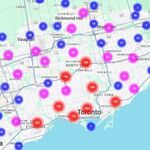Lure over the head of the Hong Kong MTR or Transport for London or some similar organization to take over the board of Metrolinx.
Give him/her carte blanche.
We'll see how the rest goes.
Good idea, though TfL is just about the last organization I'd try to recruit from. MTR would be a good choice, or pretty much anywhere in continental Europe and Japan. Madrid might be a good choice, considering their construction talents. Obviously this doesn't mean you have to recruit the most senior executive at those organizations.
Since this is supposed to be a fantasy about different spending priorities for the pot of money allocated for the City of Toronto, currently all dedicated to Transit City, I'll focus only on projects within the city. As I've said elsewhere, I think a more regional focus is important, and rapid transit on the existing GO corridors would serve a lot of intra-Toronto needs. I also won't include projects like the Yonge and Spadina subway extensions, since they're really York Region projects and are funded separately from Transit City.
Unlike some people, I'm not inherently hostile to light rail. In fact, I'm very supportive in certain contexts (i.e. Waterloo Region). The key is that it must be designed as real light rail, not the streetcars surrounded by concrete curbs stopping at every traffic light that the TTC wants to build. If they use new technologies, like GPS and traffic management software, there's no reason why they shouldn't be able to ensure that a streetcar almost never has to stop at a red light. There are a whole bunch of other things that the TTC would need to do, and I and other people have gone into some of them in other posts. Without hesitation, I'd keep the Finch LRT, though it would be worthwhile to do an actual serious study on whether the hydro corridor or Finch Ave itself is the best route. Much of the development is actually as close or closer to the hydro corridor than to the street. Eglinton, if done right, could also be well-suited to real LRT. It's essential that it be built on the Calgary rather than Toronto model, though, with ROWs outside the middle of the street where possible and real transit priority.
The people who've been talking about a rapid bus network are definitely on the right track. Whether it's limited stop service on existing routes or Rocket buses that take people from outlying neighbourhoods to major hubs (i.e. Neilson express on the 401 to Scarborough Centre), they're a fantastically economical way to really improve transit for large numbers of people. The capital cost would be minuscule. Maybe a few bus lanes here and there.
As the guy who's been pushing it for years, I'd obviously build the DRL from Dundas West and Bloor, through downtown to Pape Station and up Don Mills, elevated where possible, to Finch. It would become a new backbone of the Toronto transit system, serving a densely-developed corridor, relieving Yonge so that it serve new development and be extended north, and dramatically speeding transit for the eastern part of the city.
I also strongly support finishing Sheppard and Bloor-Danforth to STC. I'd try to build both routes as economically as possible. I'd run the Sheppard line elevated east of Kennedy and Sheppard, using the Scarborough RT right of way east of Midland. The latter would, of course, be unused because of the Bloor-Danforth subway extension.
You might notice that Malvern seems excluded, but it would be well served by two rapid transit routes along the rail corridors through the neighbourhood. They'd give a much faster and more comfortable trip to most of the city, and trips to Scarborough Town Centre would be served by rapid buses.
I haven't included the Jane LRT project, since it's a pretty complicated project and the TTC hasn't worked out how they're going to handle the section south of Eglinton. Once they do, I would look at that more closely.
The B-D extension to East Mall is obvious since a surface right of way is already available and a developer has offered free land for a station.
The most important thing is that all the projects be seriously studied, with all alternatives evaluated. While I may have read mountains of TTC studies over the years, I certainly don't have the benefit of a planning staff. I'd like to really see the cost/benefit of LRT, Skytrain/ICTS, subway, or do nothing on Eglinton, for example.
As has been mentioned, accurate cost estimates are obviously challenging without a large professional staff carrying out extensive analyses, but the figures I've included are fairly conservative based on the costs of various projects in Canada and around the world. These aren't optimistic Madrid figures.
- DRL from Dundas West station to Don Mills and Finch (~$4 billion)
- Eglinton LRT (~$2.5 billion)
- Sheppard from Downsview to STC (~$1.5 billion)
- Finch West LRT (~$700 million)
- Rapid Bus Network (~$250 million)
- Waterfront West LRT from junction with the DRL at Exhibition or Queen and Roncesvalles (~$100 million)
- Downtown streetcar network upgrades (~$200 million)
- Bloor-Danforth to East Mall (~$250 million)
- New fare system (~$500 million)




